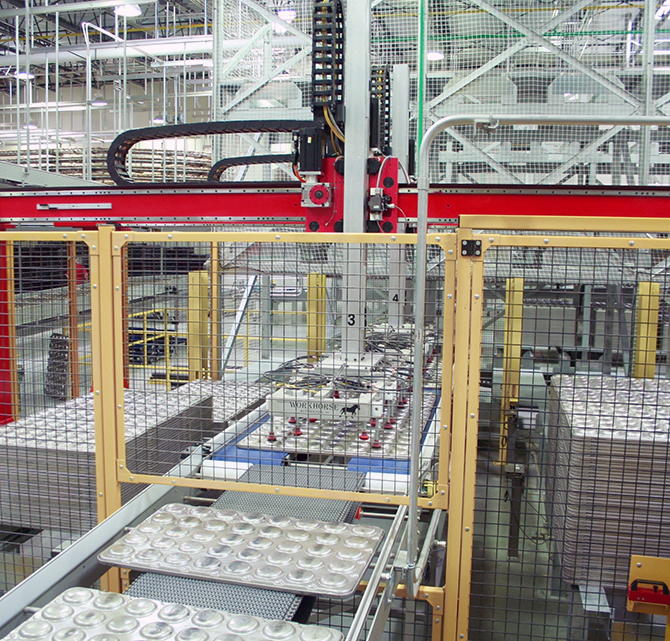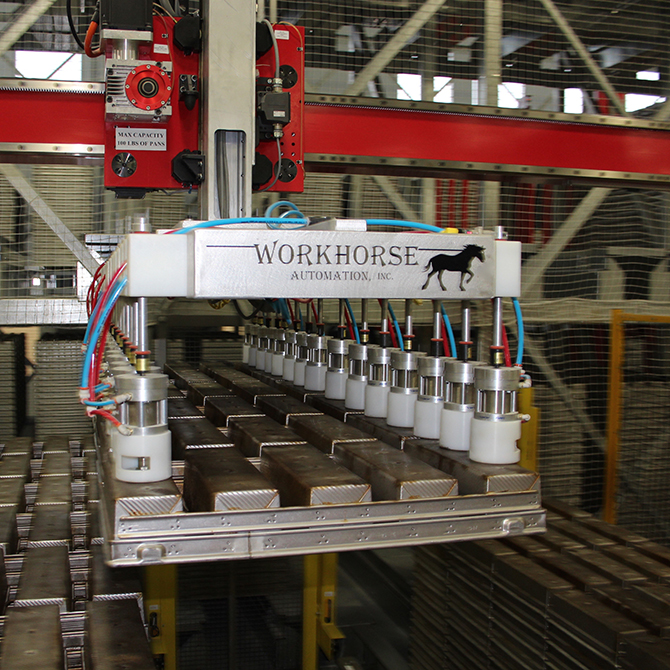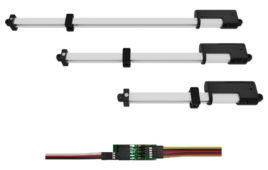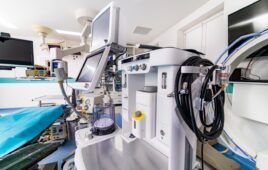In the U.S., about 50 million people a day eat at fast-food restaurants — and about 60,000 of those establishments sell hamburgers. That requires epic volumes of fresh buns every day … and only commercial bakeries with automated operations can output sufficient production volumes.
Workhorse Automation Inc. (based in Oxford, Pa.) supplies machines to this commercial-bakery industry, including pan-stacking and storage equipment such as four-axis palletizing robots. But Workhorse Automation saw that the industry needed automation solutions with even greater throughput and reach than that of stationary robots.

Here, grippers suspended from a Güdel robotic gantry (red) handle bun pans for stacking.
Established in 2003, Workhorse Automation specializes in the engineering of automated solutions for commercial baking. The machine builder sells turnkey automated bakery solutions that excel on new lines and can be retrofitted into existing lines. Top design goals are flexibility, reliability, and productivity with automated and robotic systems.
After extensive R&D, Workhorse Automation began offering equipment that includes a two-axis Güdel ZP-4 gantry robot using Allen-Bradley motion and programmable logic controls. This new solution lets Workhorse Automation end users increase stacking speeds while maintaining gentle, safe, and accurate operations.
Workhorse Automation engineers made the equipment both user and maintenance-friendly by integrating the conveying systems, end-of-arm tooling, and Allen-Bradley control to the gantry robot. The first such Güdel gantry-based system was installed in 2011 and is still in successful operation.
In fact, Workhorse Automation supplied such a Güdel-based system to the award-winning Clayton, N.C. facility of Northeast Foods – Automatic Rolls. This facility produces 1,400 buns per minute (2 million every 24 hours, primarily for McDonald’s restaurants) using Güdel gantry-based pan-stacking systems and Workhorse Automation automated storage and retrieval systems (AS/RSs).

Here Güdel ZP-4 gantry Z-axis arms handle loaf pans.
Each Workhorse Automation system includes as many Güdel ZP-4 gantry Z-axis arms as necessary to meet the throughput requirements. In some cases, two gantry arms operate over one bun-pan conveying system. Each Z-axis arm can stack and destack pans. Each customer’s application necessitates pans of different sizes and quantities — in turn needing the setting of gantry strokes in Z and Y-axes to customer-specific parameters.
Pan stacking and destacking are critical functions because pans are specific to bun type being produced. Case in point: To ensure freshness, the Northeast Foods facility makes four different bun styles every day —each requiring a different style of pan. The pan-changeover process is automatically handled by the Workhorse equipment. A human operator only needs to visually confirm that pans clear the system at production-run ends. Even changing between pan types doesn’t reduce throughput.
“Güdel gantry systems let us significantly improve pan-stacking processes,” says Workhorse automation sales manager Ken Mentch. “With the gantry robots, we can increase pan size and weight — and handle multiple pans simultaneously — even while reducing motion speed requirements. The optimized design footprint of the gantry serves just the work envelope needed for the application”, Mentch adds.
Replacing the conventional magnetic machines used previously for pan stacking — facetiously nicknamed pan crushers by the industry — reduces damage to pans and the clatter of the pan-handling process. “The gantry lets us create gentler, quieter, and smoother automation”, Mentch says.
Especially over the last couple years, the bakery industry come to recognize how gantry systems improve operation and reliability — and has begun migrating from pan crushers to this type of robotic automation. Güdel has supported Workhorse Automation through this growth.
For more information, visit gudel.com and www.workhorseautomation.com.
Filed Under: Warehouse automation, Linear Motion Tips, Robotics • robotic grippers • end effectors





Tell Us What You Think!